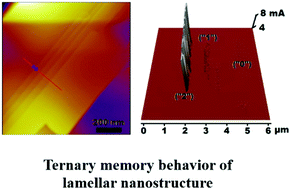Isomerization change and charge trap double mechanisms induced ternary data storage performance†
Abstract
Compared to 0 and 1 based binary systems, organic ternary data-storage systems that record data as 0, 1 and 2 can hold much more data in a given amount of cells within a storage device. Thus, how to design a functional molecule with desired film crystallinity and definite switching mechanism is the key issue for achieving excellent ternary memory devices. However, such ternary system remained less-explored due to the lack of appropriate materials. Herein, a butyl chain-substituted molecule, namely nitrobenzene-azo-carbazole (NACB), was designed and fabricated as an ITO/NACB/Al sandwich-structured device. The vacuum-deposited NACB film shows well-defined crystalline characteristics. The following electric measurement exhibited OFF to ON1 and then to ON2 tri-current states under continuous electric field, and the switching mechanism originated from the cooperated isomerization change and charge trap double mechanisms. We hope the verified mechanism can act as a model for future ternary molecular designs. The low write and read voltage (all lower than −3 V), ternary data storage abilities indicate that the device may be used for portable, low-power consumption and super-high density memory storage.



 Please wait while we load your content...
Please wait while we load your content...